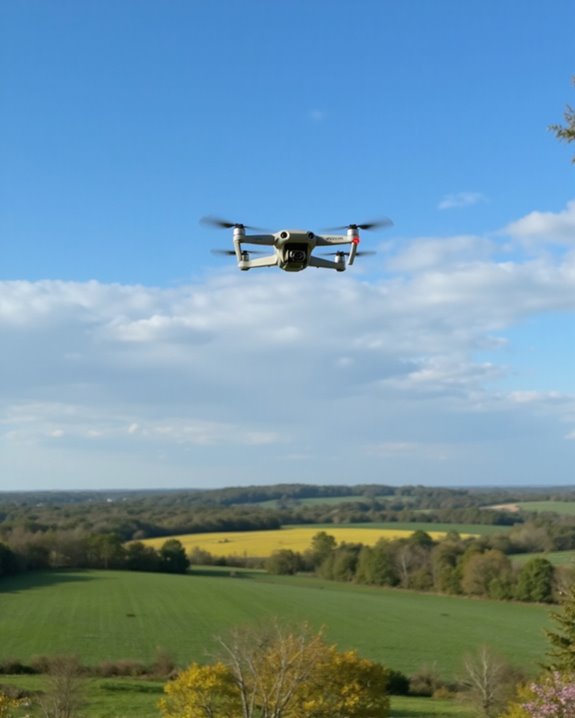Copper tape doesn’t effectively shield drones from jammers, despite its theoretical electromagnetic properties. When tested in real-world conditions, drones wrapped in copper tape still lose connection at typical ranges (300-350 meters). The tape’s effectiveness is further compromised by application challenges – gaps render it useless, and humid conditions cause adhesive failure. Plus, the added weight reduces flight time! Modern jammers easily overpower this DIY solution, making alternative strategies like encrypted communications far more reliable. The evidence from field tests tells a compelling story.
Key Takeaways
- Field tests show copper tape provides negligible protection against drone jammers in real-world conditions.
- Improperly applied copper tape can actually increase vulnerability by acting as an antenna.
- Gaps or holes in copper tape application completely negate any potential shielding benefits.
- Copper’s theoretical electromagnetic shielding properties (60-80 dB) don’t translate to effective drone jamming resistance.
- Alternative protection strategies like encrypted communications and redundant navigation systems offer more reliable defenses.
Understanding the Mechanisms Behind Drone Jammers
The fascinating world of drone jammers operates on principles that are both elegant and disruptive in their simplicity. These devices work through RF Disruption, overwhelming the communication channels between drones and their operators with electromagnetic noise that renders control signals unintelligible.
Most commercial drones operate on either 2.4 GHz or 5.8 GHz frequencies, making Frequency Matching a critical aspect of effective jamming! When a jammer broadcasts powerful signals on these same frequencies, the drone simply can’t “hear” its controller anymore. Think of it as trying to have a conversation in a rock concert – your friend’s voice gets drowned out by the overwhelming noise. The result? Drones typically hover in place, attempt to return home, or, in some unfortunate cases, fall from the sky. However, due to legal restrictions, the use of active drone jammers by civilians is prohibited, making RF-blocking products a safer alternative for signal protection.
The Science of Electromagnetic Shielding With Copper
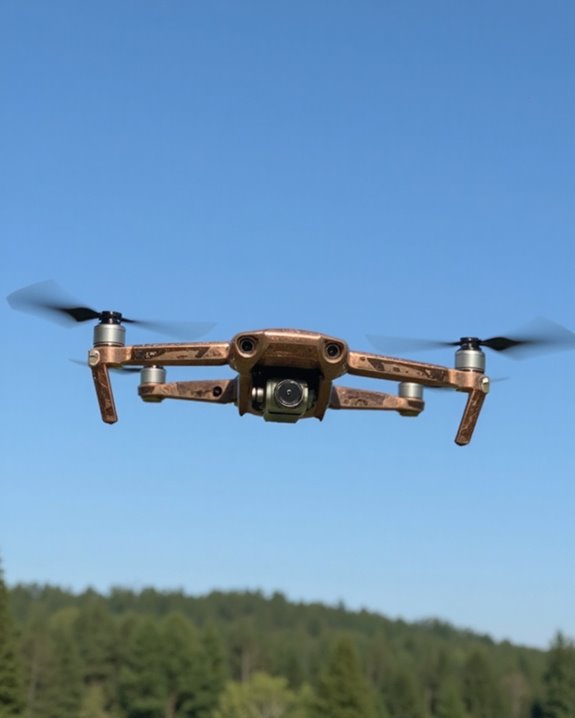
Now that we understand how drone jammers disrupt communication signals, let’s explore a potential countermeasure that’s both simple and intriguing!
Copper tape functions through basic Conduction Principles, creating a continuous electrical pathway that can shield sensitive electronics from external electromagnetic interference. When electromagnetic waves from jammers hit copper material, Reflection Effects come into play, bouncing those troublesome signals away from protected components! The science is fascinating—copper’s excellent conductivity (among the best of all metals!) allows it to effectively dissipate electromagnetic energy between 10 kHz and 20 GHz, with shielding effectiveness typically ranging from 60-80dB. Most commercial copper tapes are about 2.6 mils thick, with conductive adhesives that maintain the electrical path throughout the application area. This creates a seamless protective barrier that might just give your drone a fighting chance against those pesky jammers! For professional security use, it is essential to consider FAA-approved drone detection technologies that complement physical shielding methods.
Real-World Testing: What the Evidence Shows
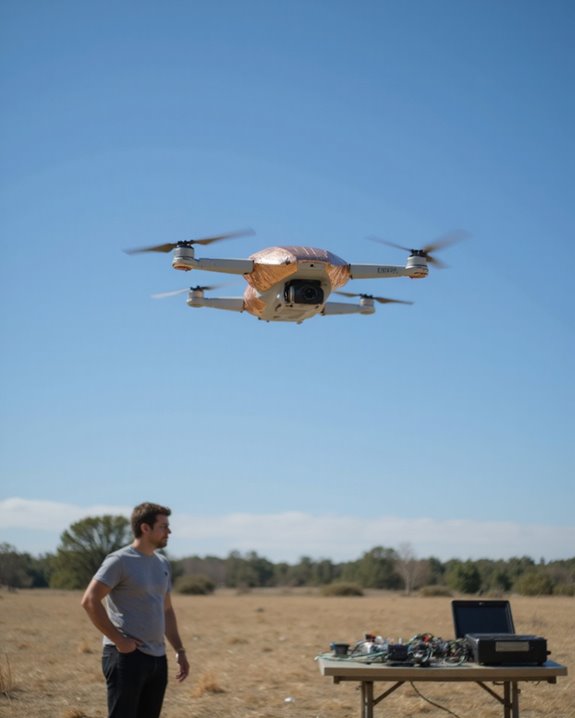
Despite all the theoretical promise of copper tape shielding, what happens when we step out of the laboratory and into the real world? The results are sobering! Controlled field tests show virtually no measurable difference in Performance Metrics between copper-taped and untreated drones when facing actual jammers.
Environmental Factors play a vital role in these disappointing outcomes. Even drones meticulously covered with copper tape still lost signal and control when jammers activated 300-350 meters away. What’s worse, improperly applied tape sometimes acted as an antenna, making drones more vulnerable to jamming! The copper’s effectiveness varies with thickness and application method, but real-world trials consistently show minimal protection against modern jammers. Those YouTube tutorials promising “complete jammer immunity” with a few strips of copper? They’re selling a dream that field testing simply doesn’t support. Additionally, factors like wind conditions above 20mph can significantly impact drone performance, further complicating resistance efforts.
Limitations of Copper Tape as a Defensive Measure
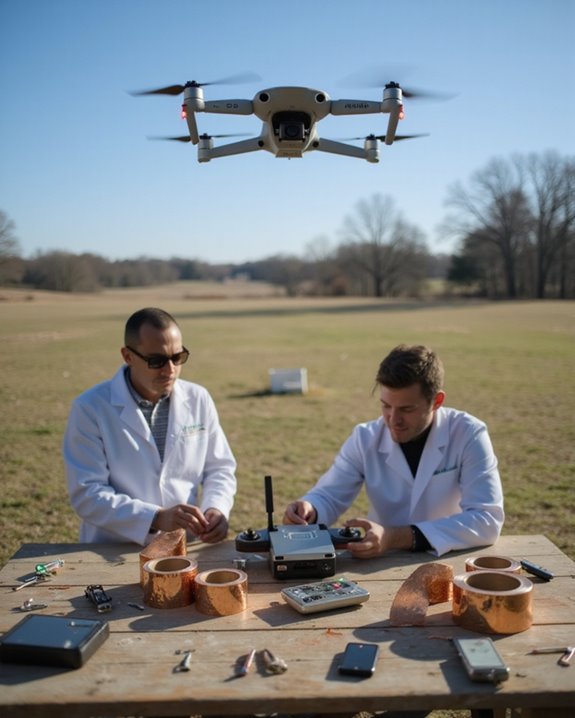
While many drone enthusiasts flock to copper tape as a magical shield against jamming signals, serious limitations exist that dramatically reduce its real-world effectiveness! The tape’s performance varies drastically depending on the frequency of jamming signals, and any gaps or holes in your application can render your protection useless.
Weather conditions can worsen these issues, with Adhesive Failure being particularly common in humid environments. Many pilots discover their carefully applied tape peeling away mid-flight! The Cost Efficiency question also looms large—is it worth investing in copper tape when environmental factors and application challenges may compromise its functionality? For heavier drones, the added weight affects flight time and maneuverability, creating a frustrating trade-off between protection and performance. Even perfectly applied tape might not shield against today’s sophisticated high-power jammers!
Community Experiences and Field Test Results
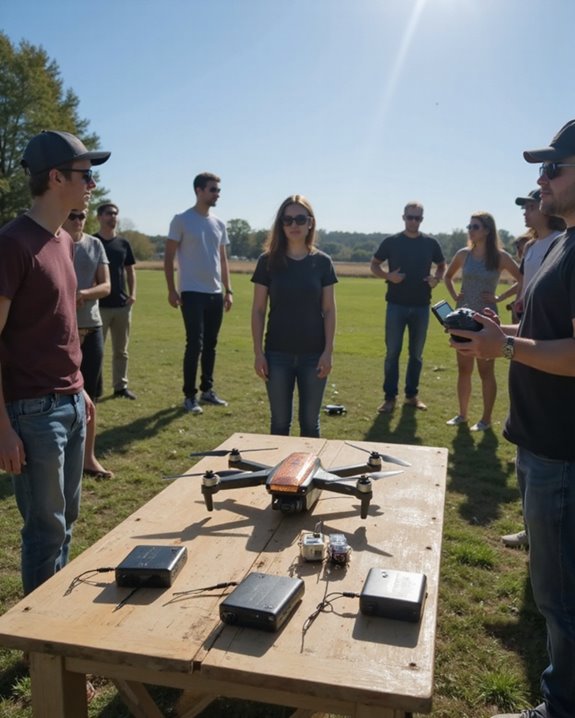
How reliable is copper tape against drone jammers in real-world conditions? User surveys across community forums tell a complicated story. Drone enthusiasts report wildly inconsistent results, with some claiming modest improvements while others saw no benefit whatsoever!
“I wrapped my Mavic in copper tape and it still dropped like a rock when the jammer kicked on,” reported one frustrated pilot in a popular drone forum. Military research backs this up — official tests show copper tape simply doesn’t create the Faraday cage effect needed for true protection.
The practical challenges are numerous, too. Copper tape wears down during flight, requires maintenance, and those pesky necessary openings for propellers and sensors? They’re basically “welcome” signs for jamming signals to enter and disrupt your flight.
Alternative Protection Strategies for Drone Operators
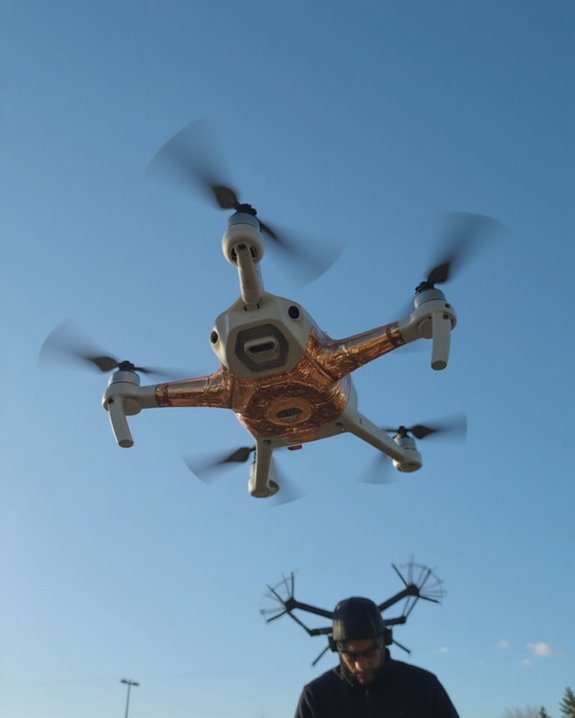
The world of drone security extends far beyond ineffective copper tape solutions, offering operators a robust arsenal of protective measures against jamming threats! Smart drone pilots now implement thorough ECCM strategies, including regular firmware updates and encrypted communication protocols that greatly reduce vulnerability to signal interference.
Zone Avoidance technology through geofencing has become essential, automatically steering drones clear of high-risk areas where jammers might operate. When signal disruption occurs, Auto Return features kick in, safely guiding your precious UAV back to its launch point without manual intervention. Isn’t that a relief?
For the serious drone enthusiast, combining multiple defensive layers—like redundant navigation systems and diverse communication channels—creates a formidable shield against even the most determined jammers. Your drone deserves nothing less than complete protection!
Frequently Asked Questions
How Does Copper Tape Thickness Affect Jamming Resistance?
Increased copper tape thickness generally enhances jamming resistance by providing better electromagnetic shielding. Thicker layers offer improved attenuation of radio frequencies, though effectiveness varies by frequency. Gaps in application substantially diminish jamming performance regardless of thickness.
Can Copper Tape Combined With Other Materials Improve Protection?
Like a fortress with multiple walls, copper tape when combined with hybrid materials increases jamming resistance. Advanced coating methods using copper alongside grounded conductive polymers or EMI mats provides superior electromagnetic shielding for electronics.
Does Copper Tape Interfere With Drone Sensors or Cameras?
Improperly applied copper tape can cause sensor interference, particularly affecting GPS and magnetometers. While cameras are less susceptible to direct EMI, poorly placed tape near wiring may introduce camera distortion or signal degradation in some cases.
How Long Does Copper Tape Shielding Remain Effective Outdoors?
With 20-30% effectiveness loss over time, copper tape shielding typically remains viable for 3-5 years outdoors. Environmental durability depends on installation quality, while regular outdoor maintenance extends its functional lifespan against electromagnetic interference.
Will Copper Tape Cause Overheating Issues in Electronic Components?
Copper tape generally does not cause overheating in electronics; it may actually help dissipate thermal effects from heat sources. However, improper application or adhesive degradation could impede heat transfer in high-temperature environments.




